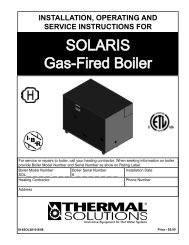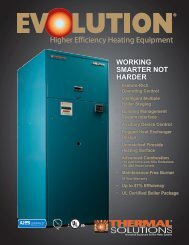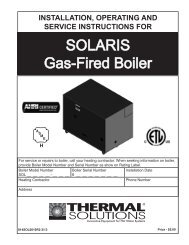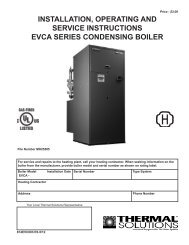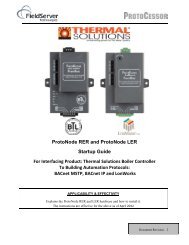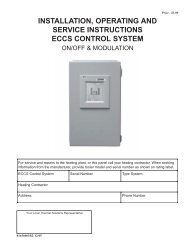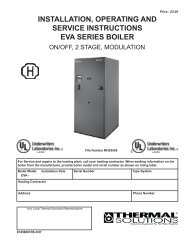I&O Manual - Solaris Water Heaters - Categories On Thermal ...
I&O Manual - Solaris Water Heaters - Categories On Thermal ...
I&O Manual - Solaris Water Heaters - Categories On Thermal ...
You also want an ePaper? Increase the reach of your titles
YUMPU automatically turns print PDFs into web optimized ePapers that Google loves.
III. Venting / Air Intake PipingWARNINGDo not use this water heater with galvanized, non metallic or any other venting material that isnot designed for condensing flue gas applications.Do not use a drafthood with this appliance.Do not use vent dampers with this water heater.Moisture and ice may form on surfaces around termination. To prevent deterioration, surfacesshould be in good repair (sealed, painted, etc.).This appliance needs fresh air for safe operation and must be installed so there are provisionsfor adequate combustion and ventilation air.Do not reduce size of air intake pipe.Read, understand and follow combustion air instruction restrictions contained in the Pre-Installationinstructions of this manual.Do not operate appliance where gasoline or other flammable vapors or liquids, or sources ofhydrocarbons (i.e. bleaches, cleaners, chemicals, sprays, paint removers, fabric softeners, etc.)are used, stored and/or present in the air.When installing vent pipe through chimney, no other appliance can be vented into the chimney.Do not exceed maximum vent/air intake lengths. Refer to Table 0.A. Vent Guidelines Due to Removal of an Existing<strong>Water</strong> heater8For installations not involving the replacement of anexisting water heater, proceed to Step B.When an existing water heater is removed from a commonventing system, the common venting system islikely to be too large for proper venting of the remainingappliances. At the time of removal of an existing waterheater, the following steps shall be followed with eachappliance remaining connected to the common ventingsystem placed in operation, while the other appliancesremaining connected to the common venting system arenot in operation:1. Seal any unused openings in the common ventingsystem.2. Visually inspect the venting system for proper sizeand horizontal pitch and determine there is noblockage or restriction, leakage, corrosion, andother deficiencies which could cause an unsafecondition.3. Insofar as is practical, close all building doors andwindows and all doors between the space in whichthe appliances remaining connected to the commonventing system are located and other spaces of thebuilding. Turn on clothes dryers and any appliancenot connected to the common venting system.Turn on any exhaust fans, such as range-hoodsand bathroom exhausts, so they will operate atmaximum speed. Do not operate a summer exhaustfan. Close fireplace dampers.4. Place in operation the appliance being inspected.Follow the Lighting (or Operating) Instructions.Adjust thermostat so appliance will operatecontinuously.5. Test for spillage at the draft hood relief openingafter five (5) minutes of main burner operation. Usethe flame of a match or candle, or smoke from acigarette, cigar or pipe.6. After it has been determined that each applianceremaining connected to the common ventingsystem properly vents when tested as outlinedabove, return doors, windows, exhaust fans, fireplace dampers and any other gas burning applianceto their previous conditions of use.7. Any improper operation of the common ventingsystem should be corrected so the installationconforms with the National Fuel Gas Code, NFPA54/ANSI Z223.1 and/or CAN/CSA B149.1 NaturalGas and Propane Installation Code. When resizingany portion of the common venting system, thecommon venting system should be resized to approachthe minimum size as determined using theappropriate tables in Part 11 of the National FuelGas Code, ANSI Z223.1/NFPA 54 and/or CAN/CSAB149.1 Natural Gas and Propane Installation Code.



